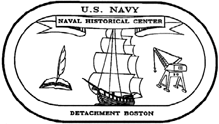USS Constitution Rehabilitation And RestorationPatrick Otton, Technical WriterNaval Historical Center Detachment Boston Bldg 24 M&R B.N.H.P. Charlestown Navy Yard Boston, MA 02129 USA 617-242-0752, phone 617-241-5232, fax e-mail: potton-nhcdetbos@worldnet.att.net  On September 26, 1995, Constitution was undocked, three years and one day after initially being brought into drydock for inspection and minor repair. Not only was Constitution repaired for her bicentennial but there was a significant change in the scope of work between the original plan and the final executed package. Restoration became the central focus where major structural hull components were restored. Known as the Strengthening Initiative, this repair is the most significant structural restoration in Constitution's history. As history can attest, Constitution represents a successful design. Joshua Humphreys, the designer of the Navy's first six frigates, that included Constitution, had two criteria to satisfy, to out gun the next rate ship and to out-sail adversaries. The solution required a never-before-built design. The successful integration of the two design criteria demanded an innovated technical solution to the problems of strength of materials and hull design. Humphreys understood that optimization of the two criteria became mutually exclusive when building a hull. The fine entry and run required for sailing qualities and the weight of a heavy armament causes particular problems for wooden hull sailing ships. Combining the weight of the guns and the buoyancy curve of a fast sailing hull results in a force that distorts the hull. The distortion known as "hog" is the bending along the length of the keel. It is the same curve that resembles the curve of a hog's back. With minimal buoyancy, the ends of the ship tend to drop down under the weight loads of the guns, while the center midbody, being more buoyant, rises upward. Humphreys recognized the need to stiffen the hull to resist the forces causing hogging. From historical research, five components were identified to have been part of Constitution's original construction.
Over the years, age began to show on the hull of Constitution. By 1992 Constitution had developed over 13 inches of hog. Many suggestions had been proposed for stiffening the hull: air bags, steel girders, and space frames. None of these were historically accurate and none were congruent with the fabric of the ship. In 1993, aware of the structural needs of an aging hull and that Humphreys had already answered these questions, NHC Detachment Boston modeled the five historical structural components. Using a 1:16 scale model of Constitution, a 10% increase in hull stiffness to resist hogging was shown. Just as Humphreys specified in 1794, the Detachment recognized in 1994 the effectiveness of the structural components and successfully extended the dry dock repair activity to include the restoration of those five structural components. The drydock repair consisted of both rehabilitation, (the repair of deteriorated structure) and restoration, (putting back into Constitution components of her 1812 configuration). To restore the structural components during the 1992 drydock repair was a justified expenditure of labor, techniques, and materials. Due to the limited availability of the required natural timber, glue lamination technology supplied much of the wood shaped to Humphreys' dimensional specifications. In 1797, while observing the launch of USS United States, Joshua Humphreys wrote to the Secretary of War, that "...without straining or hogging more than one & a quarter inch, as you will see by the enclosed certificate, to my great and unspeakable satisfaction. The firmness of the ship was convincing proof of the utility of the diagonal riders in long ships, "1 Today the same may be said for Constitution. When undocked in September 1995, the hog was measured to be less than two inches. The effectiveness of the structural components is again shown with "convincing proof" and "unspeakable satisfaction". Given the satisfactory condition of the hull and the successful completion of the repairs, Constitution is being readied to sail in celebration of her bicentennial. On July 21, 1997, for the first time since 1881, Constitution will make passage under her own sail, sailing in Massachusetts Bay under topsails, jibs, and spanker -- her battle configuration. With a Navy crew and under specified weather conditions of winds less than 15 knots and seas less than two feet, Constitution will sail again as a salute to the Nation. Joshua Humphreys is owed credit for the 200 year story of success of Constitution. It is his innovative design in building a structurally stiff hull that resolved the design criteria of fast speed under sail while carrying heavy armament. The history of this Nation rests on Constitution as a unique example of American technology. Constitution has become a lasting National symbol as a product of Humphreys' design. 1 J. Humphreys' Letter Book, 1797-1800, pg 26, dated May 11, 1797, Historical Society of Pennsylvania . Return to the Preservation Conference Schedule page.
|
